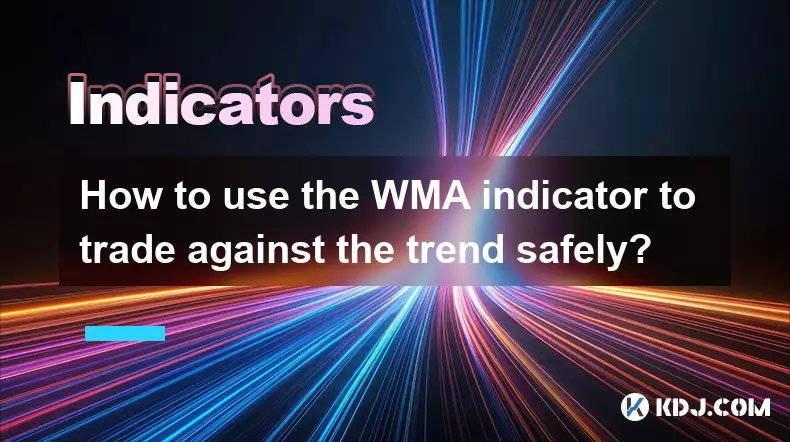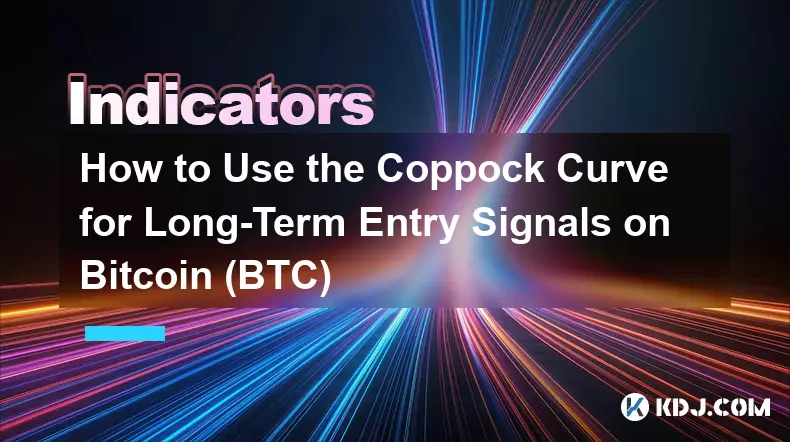-
 bitcoin
bitcoin $107015.826941 USD
-2.18% -
 ethereum
ethereum $3637.352324 USD
-5.18% -
 tether
tether $0.999831 USD
-0.02% -
 xrp
xrp $2.338078 USD
-6.23% -
 bnb
bnb $998.272150 USD
-6.97% -
 solana
solana $167.598257 USD
-10.12% -
 usd-coin
usd-coin $0.999863 USD
0.01% -
 tron
tron $0.282573 USD
-5.09% -
 dogecoin
dogecoin $0.169891 USD
-7.39% -
 cardano
cardano $0.557554 USD
-7.03% -
 hyperliquid
hyperliquid $39.914802 USD
-5.85% -
 chainlink
chainlink $15.414549 USD
-9.97% -
 bitcoin-cash
bitcoin-cash $510.361911 USD
-4.26% -
 ethena-usde
ethena-usde $0.999194 USD
-0.03% -
 stellar
stellar $0.282092 USD
-6.07%
How to use the WMA indicator to trade against the trend safely?
The WMA helps contrarian traders spot overextended moves by emphasizing recent prices, making it ideal for identifying high-probability reversal zones when combined with volume, RSI, and key support/resistance levels.
Oct 19, 2025 at 09:00 pm

Understanding the WMA Indicator in Contrarian Trading
1. The Weighted Moving Average (WMA) assigns greater importance to recent price data, making it more responsive to new information compared to simple moving averages. This sensitivity allows traders to detect potential reversals earlier, which is critical when trading against the prevailing trend. By focusing on short-term momentum shifts, the WMA helps identify overextended moves that may be due for a correction.
2. When trading counter-trend, the key is not to predict the end of a major trend but to capture short-term countertrend moves within larger market structures. The WMA acts as a dynamic support or resistance level during these pullbacks. For instance, in a strong downtrend, a temporary bounce might stall precisely at the rising WMA line, signaling a resumption of selling pressure.
3. Traders often combine the WMA with price action analysis to improve accuracy. Pin bars, engulfing patterns, or inside bars forming near the WMA can serve as confirmation signals. These candlestick formations suggest exhaustion among counter-trend buyers or sellers and increase the probability of a successful fade trade.
4. Using multiple timeframes enhances the effectiveness of WMA-based strategies. A trader might observe a daily trend but look for entries on the 4-hour or 1-hour charts where the WMA aligns with key Fibonacci retracement levels or psychological price zones. This multi-layered approach increases confidence in contrarian setups.
5. Risk management remains paramount when trading against the trend. Positions should be sized appropriately, and stop-loss orders placed beyond recent swing points. Since countertrend trades are inherently riskier, tighter stops help preserve capital even if the broader trend resumes unexpectedly.
Identifying High-Probability Reversal Zones
1. Look for extended price moves where the distance between the current price and the WMA widens significantly. Such divergence suggests momentum is peaking and a reversion toward the average is likely. In fast-moving markets, this often occurs after sharp breakouts or breakdowns fueled by news events.
2. Combine WMA readings with oscillators like RSI or Stochastic to confirm overbought or oversold conditions. When both the price is far from the WMA and the oscillator enters extreme territory, the odds of a corrective move increase substantially.
3. Pay attention to volume spikes coinciding with price deviations from the WMA. A surge in volume during an extended move may indicate capitulation or exhaustion, especially if followed by narrowing ranges. This pattern often precedes a reversal back toward the moving average.
4. Watch for failed breakouts near WMA confluence areas. If price attempts to push further in the direction of the trend but fails to close beyond the WMA, it could signal weakening momentum. These false breakouts provide actionable opportunities for contrarian entries.
5. Integrate horizontal support and resistance levels with the WMA. When the weighted average intersects with a well-established price level, the combined zone becomes a magnet for price reactions. Trading fades at these intersections improves the risk-reward profile.
Managing Trade Execution and Position Sizing
1. Enter trades gradually rather than deploying full position size immediately. Initial entries can be taken upon price touching the WMA with confirmation, followed by scaling in if momentum continues against the trend. This method reduces exposure to premature reversals.
2. Set profit targets based on prior swing levels or measured moves. Since countertrend trades aim for corrections, targeting previous consolidation zones or gap fills makes strategic sense. Avoid aiming for full trend reversals unless additional confirming factors emerge.
3. Use trailing stops linked to the WMA itself. As price moves favorably, adjust the stop-loss to follow the WMA value on each new bar. This protects profits while allowing room for natural fluctuations within the correction phase.
4. Never ignore the macro context—always assess whether the asset is in a parabolic phase or showing signs of structural weakness. A WMA-based fade trade carries higher validity when the underlying market structure begins to show fragmentation, such as lower highs in an uptrend or rising lows in a downtrend.5. Monitor order book depth in cryptocurrency markets. Thin liquidity beyond key WMA levels can lead to rapid reversions. Large bid or ask walls appearing near the WMA on exchange order books often precede sharp mean-reverting moves, offering real-time validation of technical signals.
Frequently Asked Questions
What timeframe works best for WMA-based contrarian strategies?The 1-hour and 4-hour charts offer a balanced view between noise reduction and timely signals. Shorter timeframes increase false signals, while longer ones delay entry timing. Combining WMA analysis across these frames improves decision quality.
Can the WMA be used alone for counter-trend entries?Relying solely on the WMA is risky. It performs best when aligned with other tools such as volume profiles, order flow indicators, or confluence with key price levels. Confirmation from multiple sources increases reliability.
How do you adjust WMA periods for volatile crypto assets?In highly volatile environments, shorter WMA periods like 9 or 14 react faster to price swings. During stable phases, extending to 20 or 21 smooths out noise. Adapting the length based on average true range (ATR) readings helps maintain consistency.
Is it safe to use WMA signals during major news releases?Trading against the trend using WMA during high-impact news is discouraged. Price gaps and slippage can invalidate technical levels quickly. Wait for volatility to settle and price to retest the WMA before considering entries.
Disclaimer:info@kdj.com
The information provided is not trading advice. kdj.com does not assume any responsibility for any investments made based on the information provided in this article. Cryptocurrencies are highly volatile and it is highly recommended that you invest with caution after thorough research!
If you believe that the content used on this website infringes your copyright, please contact us immediately (info@kdj.com) and we will delete it promptly.
- Ripple Competitor Alert: Is Remittix the Next Top 10 Crypto Challenger to XRP?
- 2025-11-04 20:10:02
- MEXC, USDf, and Trading Volume: A Deep Dive into Recent Developments
- 2025-11-04 19:15:01
- Meme Coins and Market Dynamics: Navigating the Crypto Landscape in Late 2025
- 2025-11-04 20:10:02
- Bitcoin, Crypto, and EcoYield Bonus: Is This the Smartest Play Now?
- 2025-11-04 19:15:12
- Cardano (ADA) and Altcoin Growth: Navigating the Landscape
- 2025-11-04 19:15:12
- Solana ETF, Institutional Battle, and Western Union: A New Era for Crypto?
- 2025-11-04 20:10:01
Related knowledge

Technical analysis for crypto: using RSI and MACD to find trading signals.
Nov 03,2025 at 03:18pm
Decentralized Exchanges Are Reshaping Trading Dynamics1. Decentralized exchanges (DEXs) have gained significant traction by eliminating intermediaries...

The Best Exponential Moving Average (EMA) Settings for Crypto Swing Trading
Oct 25,2025 at 04:55pm
The Best Exponential Moving Average (EMA) Settings for Crypto Swing TradingSwing trading in the cryptocurrency market relies heavily on identifying tr...

How to Use the Coppock Curve for Long-Term Entry Signals on Bitcoin (BTC)
Oct 31,2025 at 03:01pm
Understanding the Coppock Curve in Bitcoin Analysis1. The Coppock Curve is a momentum indicator originally designed for stock market indices but has f...

A Beginner's Guide to Finding Divergence with the MACD on the Solana (SOL) Chart
Oct 26,2025 at 12:36pm
Understanding MACD and Its Role in Solana Trading1. The Moving Average Convergence Divergence (MACD) is a momentum indicator widely used in cryptocurr...

How to Use the Aroon Indicator to Identify New Trends in Cardano (ADA)
Oct 26,2025 at 10:18pm
Understanding the Aroon Indicator in Cryptocurrency Trading1. The Aroon indicator is a technical analysis tool designed to identify whether an asset i...

Trading the Ichimoku Cloud "Kumo Twist" for Ethereum (ETH) Reversals
Oct 27,2025 at 01:54am
Understanding the Ichimoku Cloud and Its Components1. The Ichimoku Cloud, also known as Ichimoku Kinko Hyo, is a comprehensive technical analysis tool...

Technical analysis for crypto: using RSI and MACD to find trading signals.
Nov 03,2025 at 03:18pm
Decentralized Exchanges Are Reshaping Trading Dynamics1. Decentralized exchanges (DEXs) have gained significant traction by eliminating intermediaries...

The Best Exponential Moving Average (EMA) Settings for Crypto Swing Trading
Oct 25,2025 at 04:55pm
The Best Exponential Moving Average (EMA) Settings for Crypto Swing TradingSwing trading in the cryptocurrency market relies heavily on identifying tr...

How to Use the Coppock Curve for Long-Term Entry Signals on Bitcoin (BTC)
Oct 31,2025 at 03:01pm
Understanding the Coppock Curve in Bitcoin Analysis1. The Coppock Curve is a momentum indicator originally designed for stock market indices but has f...

A Beginner's Guide to Finding Divergence with the MACD on the Solana (SOL) Chart
Oct 26,2025 at 12:36pm
Understanding MACD and Its Role in Solana Trading1. The Moving Average Convergence Divergence (MACD) is a momentum indicator widely used in cryptocurr...

How to Use the Aroon Indicator to Identify New Trends in Cardano (ADA)
Oct 26,2025 at 10:18pm
Understanding the Aroon Indicator in Cryptocurrency Trading1. The Aroon indicator is a technical analysis tool designed to identify whether an asset i...

Trading the Ichimoku Cloud "Kumo Twist" for Ethereum (ETH) Reversals
Oct 27,2025 at 01:54am
Understanding the Ichimoku Cloud and Its Components1. The Ichimoku Cloud, also known as Ichimoku Kinko Hyo, is a comprehensive technical analysis tool...
See all articles










































































